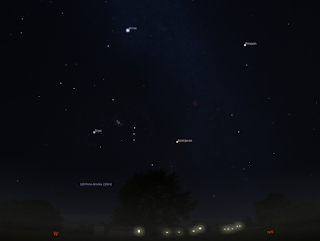The First Quarter Moon is Wednesday, May 15. Comet 12P Pons-Brooks is now visible when the sky is fully dark but is still a binocular only object. The comet will progressively climb higher and is near the iconic Orion constellation. In the morning the lineup of Saturn, Mars and Mercury makes for nice viewing.
The First Quarter Moon is Wednesday, May 15.
Evening
sky on Thursday, May 9 as seen from Adelaide at 18:52 ACST (90
minutes after sunset, click to embiggen). Comet 12P is below Orion close to the star nu Eridanus in the constellation of the river.
While the comet is a modestly bright magnitude 5, despite now being visible when the sky is fully dark, you will still need binoculars. Over the week the comet will climb towards Orion and into darker skies, but becomes dimmer as it rises. Updated spotters charts are here.
Similar views will be seen from the rest of Australia at the equivalent local time (90 minutes after sunset).
Evening
sky on Thursday, May 16 as seen from Adelaide at 18:52 ACST (90 minutes
after sunset, click to embiggen). Comet 12P is now just below Orion when the sky is fully dark. The inset shows the binocular view at this time.
While
the comet is a reasonable bright magnitude 5.4, you will still need binoculars. Over the week the
comet will climb higher into darker skies and closer to the bright stars of Orion. Updated spotters charts are here.
Similar views will be seen from the rest of Australia at the equivalent local time (90 minutes after sunset).
Morning
sky on Saturday, May 11 as seen from Adelaide at 05:337ACST, (60 minutes before sunrise, click to embiggen). Saturn, Mars and Mercury make an attractive lineup.
Similar views will be seen from the rest of Australia at the equivalent local time (60 minutes before sunrise).
Whole sky on Saturday, May 11 as seen from Adelaide at 18:51 ACST, 90 minutes after sunset (click
to embiggen). Orion is low in the north-west. Bright Sirius is still dominant in the north-western sky. Scorpius is rising in the East. Between the bright star
Canopus and the Southern Cross are a wealth of binocular objects to
discover. This is a good time to see fainter clusters.
Elsewhere
in Australia will see a similar view at the equivalent time (90 minutes after sunset).
Mercury begins to sink into the twilight.
Venus is lost in the morning twilight.
Mars is rising in the morning twilight.
Jupiter is lost in the twilight sky.
Saturn climbs higher in the morning twilight.
Labels: weekly sky










